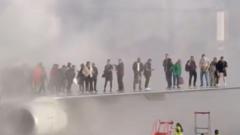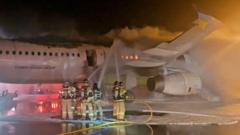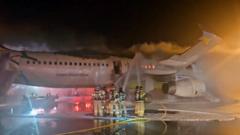On January 29, 2025, an Air Busan flight preparing to depart from Busan, South Korea, erupted in flames, causing panic among passengers. The incident, occurring shortly after a tragic aviation disaster in South Korea, highlights critical safety concerns.
Chaos Unfolds as Passengers Escape Fiery Plane Outbreak

Chaos Unfolds as Passengers Escape Fiery Plane Outbreak
A frightening fire on Air Busan Flight ABL391 left nearly 170 passengers scrambling to safety moments before takeoff.
On the evening of January 29, 2025, a harrowing scene unfolded at Busan's airport as Air Busan Flight ABL391 faced a life-threatening fire just moments before its scheduled departure to Hong Kong. Nearly 170 passengers were onboard when flames erupted in the rear section of the Airbus A321, a situation exacerbated as the captain neglected to initiate an evacuation order despite urgent warnings.
The fire ignited near the back of the cabin, and reactions were immediate as passengers spotted smoke and flames emerging from the overhead bins. With the Lunar New Year celebrations in full swing, the atmosphere was already charged with excitement, quickly turning to confusion and panic as the reality of their dire situation set in.
Shin Min-su, a passenger onboard, shared his experience, noting, “Flames were coming out of the gaps between the overhead bin doors. People were screaming trying to get out, but there was a line so they were stuck.” His instinct was to help, but a flight attendant quickly intervened, cautioning him against opening the overhead bins.
The timing of this incident raised alarm bells, as it followed closely on the heels of South Korea's deadliest aviation disaster, which had left the nation in mourning and on high alert regarding flight safety. Witnesses reported chaotic scenes with passengers shouting and pushing each other in their desperate bid for escape.
Air Busan's Flight ABL391 had been delayed shortly before its intended takeoff at 10:15 p.m. However, as convention waned and passengers made way for potential disaster, it became evident that safety protocols needed earnest reconsideration to avoid repeating the past's grave mistakes.

















